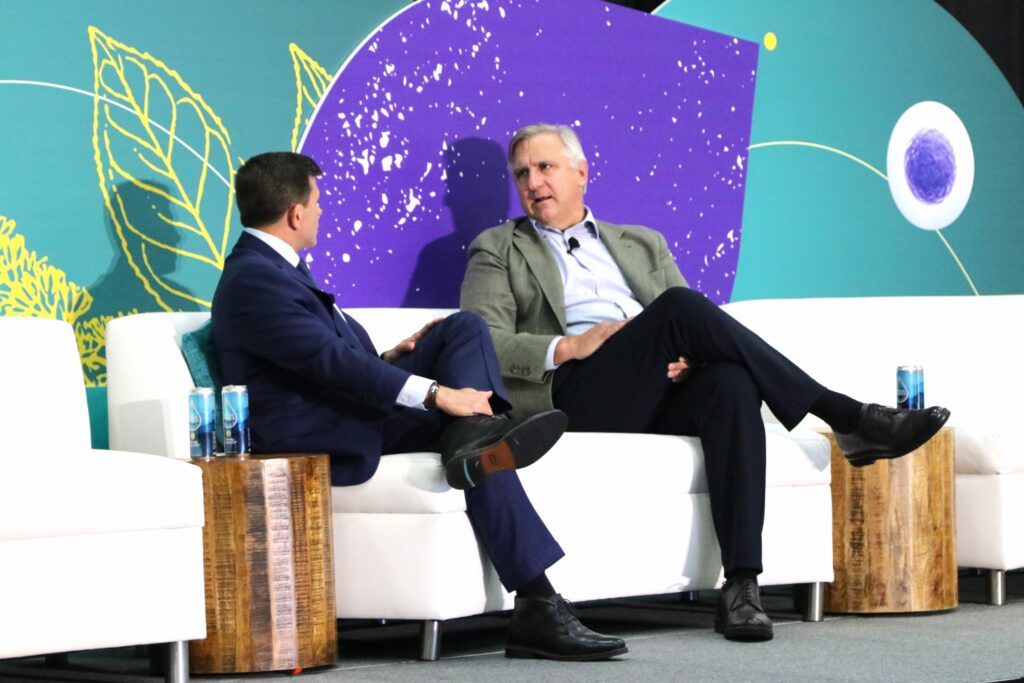Founded 44 years ago, Amgen was “created at the dawn of the biotechnology revolution,” said Robert A. Bradway, CEO of Amgen, “when faculty at Stanford discovered that you could recombine DNA across organisms and, and, and make proteins that were otherwise unavailable as human therapeutics.”
“Our mission is simple. It’s to serve patients,” he said, speaking at a fireside chat with BIO President & CEO John F. Crowley on June 4 at the 2024 BIO International Convention in San Diego.
Amgen’s mission, he continued, “is very clearly focused on innovative medicines.” But even for a company around for so long, with so many successes, that mission is increasingly challenging due to changes in the policy and investment ecosystem.
The impact of the Inflation Reduction Act on innovation
“Ours is a challenging industry, right? This is an industry where now, on average, we’re investing $2.5 billion to bring a molecule from discovery stage to the stage where it can be approved or not by regulators,” said Bradway, and 10-15 years to get there. “The risks are high and the stakes are high. And that creates a great deal of complexity, as you know.”
Now, provisions in the Inflation Reduction Act (IRA)—specifically related to small molecule drugs—make that process even riskier by reducing the window for patent protection to nine years rather than the 13 years given to biologics. This could prove particularly challenging for oncology research.
“I would venture to guess that none of the legislators who advocated for that legislation recognize what the long-term effect will be on oncology research in this country,” he noted—which is unfortunate because “we’re at an extraordinary moment in time where technology and biology are coming together.”
That nine-year window “I think is going to prove to be unrealistic,” he said. “The net result will be exactly what you’d expect: when the returns of an industry go down, the investment in the industry follows. So, we will see a reallocation of capital, certainly away from those parts of our industry which the IRA most directly affects, like small molecule research.”
“It is unfortunate that there are some interesting, promising small molecules for cancer research that that may not see the light of day,” he continued.
‘Get back to the storytelling’
The conversation turned to perceptions of the biotech industry, which improved somewhat during COVID-19, but now, “we’ve fallen back,” said Crowley. “How do we get that narrative back?”
“There’s nothing more important than innovation to demonstrate to the world, the benefit of investing in biopharmaceutical innovation,” said Bradway. “We need innovation and we need patients to have access to that innovation for us to win the narrative in the public domain.”
The good news: there’s plenty of innovation in the pipeline.
The bad news: “We live in a system where lots of different entities are able to profit from or even profiteer from medicines,” causing prices to look high, even when innovators (drug companies) didn’t benefit.
We have accumulated “unintended consequences of decades and decades and decades of these evolutionary steps in the health care system,” he continued, from middlemen to cost of recordkeeping.
Bipartisan recognition of the value of biotech innovation long allowed innovation to flourish. “We enjoyed for many decades a bipartisan understanding of the value of the biopharmaceutical industry. Unfortunately, we don’t enjoy that anymore,” he said. (Case in point: the Inflation Reduction Act.) Now, we have to recognize that ecosystem—and all the medicines it developed—is “fragile,” and we may miss out on future innovation if we don’t fix it.
It comes down to telling the industry’s story—and ensuring policymakers understand the industry.
“Our mission is very clear. We want to advance to serve patients. We want to do that with medicines that make a big difference for those who are suffering from diseases where the unmet medical need is high,” he said. By combining that mission with a “science-based” strategy focused on innovation, “I think you have a recipe for success through a long period of time.”
“Get back to the storytelling,” echoed Crowley. “Humanize who we are, what we do, why we do it, where we do it. And that’s how we’ll change the narrative.”




